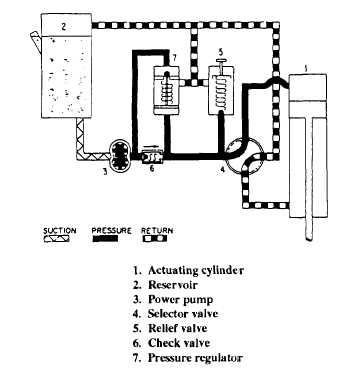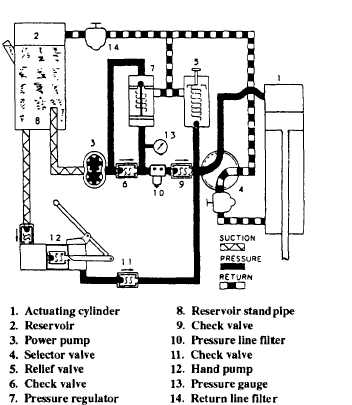relieve system pressure before it becomes sufficient enough to rupture the system or damage the pump. The relief valve ball is unseated at a predetermined pressure, and excess fluid is bypassed to the reservoir.
At this point, figure 10-33 illustrates a workable system, but it is still impractical. After a few hours, an ordinary pump would probably fail because it has to maintain a constant load. (The pump is keeping the relief valve unseated except when the cylinder is being moved.) With the addition of a check valve and pressure regulator (fig. 10-34), the work load on the pump is relieved and the system is more efficient, safer, and more durable. (A variable volume pump with its own built-in pressure control serves the same purpose in a system as the pressure regulator valve in this system.) The pressure regulator maintains system pressure between two predetermined pressure limits and relieves the pump when no mechanisms are moving, bypassing the pump flow unrestricted back to the reservoir. When you are adding the regulator valve to the system, the relief valve becomes a safety valve, used to prevent system damage in case of regulator or variable volume pump control failure.
The hydraulic system (fig. 10-34) is a practical, workable system; however, today's more complex equipment normally incorporates more components for

Figure 10-34.-Hydraulic system with a relief valve and regulator incorporated.

Figure 10-35.-Complete hydraulic system.
the purpose of increasing efficiency, safety, and emergency or standby operation.
A complete hydraulic system is shown in figure 10-35. In addition to the components already mentioned, this system includes more check valves, pressure gauge, filters, and a hand pump. The hand pump is added as art auxiliary system, normally used as an emergency power source in case of main power pump failure.
The complete hydraulic system discussed above may be further expanded by including a pressure manifold, more selector control valves, actuating mechanisms, and more power-driven pumps connected in parallel. You should remember that all systems can be broken down into a simplified system (as illustrated in figures 10-32 through 10-35). Thus, even the most complex system can be analyzed, not from the standpoint of a complex system but from that of a simple system.
TYPES OF HYDRAULIC SYSTEMS
There are two types of hydraulic systems used in support equipment. A system may be either an open center or a closed center, or in some cases, both.
Continue Reading